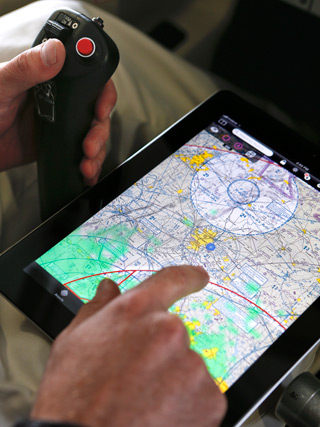Avionics: Improve your FlyQ
Flight plans, charts, plates, and more
 AOPA has introduced a new member to the FlyQ family. FlyQ EFB is a full-featured application that builds on the popular FlyQ iPhone and Android flight planning software.
AOPA has introduced a new member to the FlyQ family. FlyQ EFB is a full-featured application that builds on the popular FlyQ iPhone and Android flight planning software.
Now with moving maps, approach plates, and many other unique and useful features, FlyQ EFB is a must-try for aviation iPad users. The application builds on the initial FlyQ application (now called FlyQ Pocket) that was optimized for phones and gives users an experience that is perfectly suited to the iPad (with Android tablet support in the works).
Navigation is done through five tabs on the bottom of the screen—airports, weather, plans, maps, and procedures. That navigation bar and a bar at the top featuring a search box, lock button (to lock the screen orientation), screen brightness adjustment, download manager, and settings menu are consistent throughout the application.
Users of the original FlyQ application (which remains a free resource for all AOPA members) will recognize the airports page. Navigation is the same, with nearby airports listed by default, but favorites and recently used airports available by quickly selecting a tab. The airport list gives information that’s quick to browse, including frequencies, weather condition, runway length, and more. Click on one and you’re taken to the airport page with everything you’d expect, including a list of instrument procedures for those who have purchased the VFR and IFR subscription level.
The weather tab is also brought over from FlyQ, with nearby radar, plain-language or raw METARs and TAFs, winds aloft, and an area weather briefing shown by default. From here users can look at weather graphics, or use a crosswind calculation tool. 
Seattle Avionics, which developed the application in partnership with AOPA, is a leader in electronic flight planning, and this comes through on FlyQ EFB. The plans tab is an easy-to-use flight planning engine that will auto-generate a plan with full route guidance based on airways, direct, and more. Once the plan is complete, the user can read a weather briefing (no need to request one separately), or file a flight plan by pressing a single button.
Unique among full-featured iPad applications is the ability to plan a flight from any FlyQ device and grab it from any other platform. So you can plan your flight on the computer with FlyQ Flight Planner, and then access it from FlyQ EFB. That works back and forth through computer, iPad, or phone.
Whether the plan is filed or not, it shows up on the maps tab. This is a full-screen display with sectionals (VFR package)—and low-altitude, or high-altitude IFR charts (VFR and IFR package)—that show the aircraft’s current location as it moves over the map. Radar, satellite, METARs and TAFs, winds aloft, TFRs, and the flight plan all can be overlaid on the charts. There’s also a status box that shows the GPS status and the age of the displayed weather.
Finally, the procedures tab displays instrument approach charts, which can be selected either through scrolling through the airport’s full range of options, or by going to the airports tab and selecting the desired plate. Georeferenced airport diagrams are included for both the VFR and IFR package, which is a huge safety benefit. Georeferenced instrument approaches are included in the IFR package. Another nice feature is that expired plates are clearly labeled as such with a red bar at the top, making it quick and easy to discern what’s current and what’s not.
 There are many features that make FlyQ EFB even more user-friendly, including the ability to view split-screen. A simple touch of the button in the top menu bar will split the screen in half, giving the user dozens of different viewing combinations. Synthetic vision in 3D and highway in the sky boxes are also standard in both packages.
There are many features that make FlyQ EFB even more user-friendly, including the ability to view split-screen. A simple touch of the button in the top menu bar will split the screen in half, giving the user dozens of different viewing combinations. Synthetic vision in 3D and highway in the sky boxes are also standard in both packages.
There’s also a virtual primary flight display that will operate with an input from the Levil Technology mini-AHRS, which is sold directly from Levil. Finally, while weather and traffic are not available on the initial release, the software is built in such a way that it will work with any weather input which will reciprocate. Those partnerships should be coming soon.
Pricing
AOPA members receive a 30-percent discount on the standard pricing by purchasing the application directly from the AOPA website. When purchased from here, the yearly VFR package is $69.99 and the VFR and IFR package is $119.99. If purchased directly through the Apple store, the yearly VFR package is $99.99 and the VFR and IFR package is $174.99. A free 30-day trial is available.
Email [email protected].


